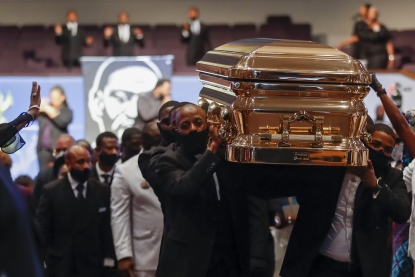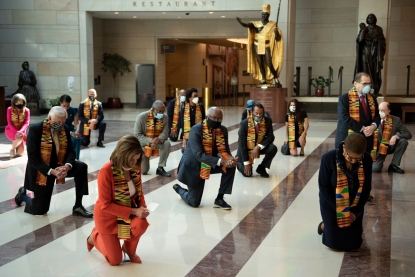Behind the camera: Black Lives Matter
The death of George Floyd, six weeks ago, triggered a cultural and social earthquake in the United States, with several aftershocks, as Americans demanded an end to systemic racism. AFPTV covered protests in more than a dozen cities. Video editor-in-chief for North America, Jihan Ammar, and her colleagues Salima Belhadj, Gilles Clarenne and Gianrigo Marletta write here about how the team operated, how the story impacted our journalists and sparked ethical debate in the newsroom.
Washington D.C - It was going to be the biggest story of 2020 - the US election. We had been preparing for it since 2016. Trump's election ushered an avalanche of interest in US news and prompted us to embark on a major overhaul of our entire US video operation. We boosted staff levels, from 7 to more than 20, spread people across the country, opened a "Master Control Room" for live feeds and cultivated relationships with freelancers all over the United States.
By the fall of 2019, more than a year before the 2020 presidential election, coverage plans were ready. Everyone was excited for the start of election year. Our first indication that 2020 was not going to go according to plan was the emergence of COVID-19. Remote working was established quickly and our network around the country held strong. And then George Floyd was killed. We put a veteran video journalist on a plane to Minneapolis quickly. Another one followed after the first night of heavy rioting. And then the protests spread across the country.
Minneapolis, New York, California, Miami, Houston, Atlanta, Detroit, Seattle, Cleveland, Chicago, Las Vegas, Philadelphia, Washington, DC.… We quickly had coverage by staff VJs and regular contributors in 14 American cities.
Our wide network of freelance video journalists supported the staff coverage with powerful images where sporadic protests and looting erupted. We trained them to provide lives with their phones. These 'immersive' lives were perfect for moving protests and allowed video journalists to make it through long, grueling days with lighter equipment. It was safer too when there was a chance of clashes.
One of the first videojournalists on the ground was Gilles Clarenne. “I went from a stay-at-home order imposed in Washington DC, to being amongst hundreds of protesters in Minneapolis”, he recalls. “For three days, peaceful protests during the day turned into looting and burned down buildings at night”.
 A protester reacts standing in front of a burning building set on fire during a demonstration in Minneapolis, Minnesota, on May 29, 2020, over the death of George Floyd, a black man who died after a white policeman kneeled on his neck for several minutes. (AFP / Chandan Khanna)
A protester reacts standing in front of a burning building set on fire during a demonstration in Minneapolis, Minnesota, on May 29, 2020, over the death of George Floyd, a black man who died after a white policeman kneeled on his neck for several minutes. (AFP / Chandan Khanna)Smoke was still coming out of the businesses burned down by protesters the night before when my colleague photographer Kerem Yucel and I discovered the scene. We heard people shouting “We can’t breathe” soon after, as they gathered in front of the police precinct where the officer who kneeled on George Floyd worked.
That night, the protesters set the Minneapolis police station on fire.
Our images were seen live on many tv networks across the world.
“I filmed live, most of the time, wearing a helmet and a tear gas mask. I remember one protester, Chicago, who would not give his real name, facing police officers and asking them Do you believe in white privilege ? I realized I was, myself a white reporter who moved to the US from Belgium”, Gilles also told me.
Gianrigo Marletta, based in Miami, was one of the VJs who volunteered to be sent on assignment to Minneapolis, around three days after Floyd's death.
Working with AFP photographer Chandan Khanna - he jumped into a rental car at the Minneapolis airport and headed straight to the protests. “They weren’t hard to find, we just had to follow the thick black smoke gushing into the air from Midtown Minneapolis”, he told me.
“The sun was slowly going down”, he recalls for this blog. “Gilles Clarenne was running low on transmitter batteries. We met amid a marching protest and I took over, keeping AFPs Live coverage rolling. It was a moving coverage. No tripod. Live transmitter in a backpack, camera at hand and try to walk, avoid flying objects, watch your back for angry protestors, watch your front for anti-riot police, be aware of cars on fire and of course - film everything as smoothly as possible”.
“My assignment lasted one week, which felt like a month. Although it was mostly an adrenalin-driven kind of coverage, I had the chance of deep reflection - as everyday, for seven days, I stood in the spot where George Floyd died. I watched large numbers of people of all colors, ages, sex preferences come together to cry, pray, be angry and discuss with each other. I interviewed people whose words I hope will be listened to, widely and internationally, now and for a long time to come”, Gianrigo Marletta wrote.
For all of us back at the office, emotions were also high. Mine too.
 Pallbearers carry the casket following the funeral of George Floyd June 9, 2020, at The Fountain of Praise church in Houston. - George Floyd will be laid to rest Tuesday in his Houston hometown, the culmination of a long farewell to the 46-year-old African-American (AFP / Godofredo A. Vasquez)
Pallbearers carry the casket following the funeral of George Floyd June 9, 2020, at The Fountain of Praise church in Houston. - George Floyd will be laid to rest Tuesday in his Houston hometown, the culmination of a long farewell to the 46-year-old African-American (AFP / Godofredo A. Vasquez)PS: Are you black or white? That question was written at the end of a love note passed hesitantly to my sister in her elementary school class. It was an awakening for our immigrant family to the reality of living in the American South in the 1980s. From then on, we understood that everything in the US is about race. The color of your skin determined whose side you’re on, who you sat with at lunch break and who you loved.
We were not taught about the 1921 Tulsa race riots or Juneteenth in school. It wasn’t until my college years in upstate New York that an African-American teacher explained racism is a power issue. We then read Toni Morrison and Alice Walker, watched everything Spike Lee did. Black was in fashion. But it didn’t change the status quo.
 People raise their hands as they protest at the makeshift memorial in honour of George Floyd, on June 4, 2020 in Minneapolis, Minnesota. (AFP / Chandan Khanna)
People raise their hands as they protest at the makeshift memorial in honour of George Floyd, on June 4, 2020 in Minneapolis, Minnesota. (AFP / Chandan Khanna)Watching the video of George Floyd suffocating for 8 minutes and 46 seconds set off a fuse in a country under COVID-19 lockdown and with record high unemployment.
The protesters had nothing to lose. Explosive anger stripped away all coronavirus protocols. We knew this was going to be a watershed moment in a year like no other.
At the same time, there was a learning curve on attitudes and language around racism in the US for some international colleagues who had not been here long.
A free lancer in New Orleans refused an assignment for ethical issues – she is white and thinks the story belonged to the African-American community, which triggered a debate among us. “Can white reporters write authoritatively about this story?” a colleague asked. “How diverse is our newsroom?” we asked ourselves.
When the New Orleans video journalist said she could recommend journalists ‘of color’ for the job, my French colleague found the term offensive, harking back to slavery. No, in America, it’s politically correct I explained. It’s confusing, and it’s uniquely American.
We made sure we were interviewing black protesters over white ones and giving voice to a community that is woefully under-represented in the media. At the start of the protests in Minneapolis, white protestors made a point of refusing to speak to reporters and waved them over to black protestors. For analysis it felt painfully wrong to interview white experts on what was happening in the country. It wasn’t just about optics, but whose voice we were amplifying. It was about the basic mission of journalism, to witness, to give a voice.
For some of us, it was a personal story as well. Salima Belhadj, who is deputy video editor-in-chief for North America, and arrived in 2019, told me she had, in a way, discovered when arriving here that she was a “white woman”, married to a “black man”.
 People raise their hands and kneel down as they protest at the makeshift memorial in honour of George Floyd, on June 2, 2020 in Minneapolis, Minnesota. (AFP / Chandan Khanna)
People raise their hands and kneel down as they protest at the makeshift memorial in honour of George Floyd, on June 2, 2020 in Minneapolis, Minnesota. (AFP / Chandan Khanna) A Somali-American couple, alongside protesters calling for justice for the death of George Floyd, waits after curfew outside the Cup Foods on June 1, 2020 in Minneapolis, Minnesota. (AFP / Kerem Yucel)
A Somali-American couple, alongside protesters calling for justice for the death of George Floyd, waits after curfew outside the Cup Foods on June 1, 2020 in Minneapolis, Minnesota. (AFP / Kerem Yucel)
This is what she wrote to contribute to this blog:
"It would never have occurred to me to present my family as mixed-race or myself as 'white' but since moving to the United States, practically everything is connected to our race. When filling in forms, you're asked to check a box to identify your race. I have no problem checking a box. My only problem is I don't identify with any of the boxes as 'African' or 'Arab' aren't there.
Yes, I am French, but as I don't consider myself 'white' I don't check anything. It's a whole other story for my husband. He knows exactly which box to check. But he also knows in the United States that means some people might want him dead.
Neither of us can watch the video of George Floyd's death to the end. But watching him pinned to the ground and the cold stares of the police, my husband says he doesn't feel 'safe'. Being Black is a real problem in this country, he said to me. I was relieved, for once, not to be on the ground covering a story that affected me so directly.
 Democratic lawmakers take a knee to observe a moment of silence on Capitol Hill for George Floyd and other victims of police brutality June 8, 2020, in Washington, DC. (AFP / Brendan Smialowski)
Democratic lawmakers take a knee to observe a moment of silence on Capitol Hill for George Floyd and other victims of police brutality June 8, 2020, in Washington, DC. (AFP / Brendan Smialowski)One moment particularly touched me. In Minneapolis, the day after the police department was set on fire, a young man, "Chicago", stood in front of a line of police officers and expressed his anger.
It reminded me immediately of the opening minutes of the French film "La Haine" by Mathieu Kassovitz, filmed in my neighborhood, Les Sapins, in Rouen (north of France) during clashes in 1994 after the death of resident Ibrahima Sy while fleeing French police. Ten years later, I interviewed Ibrahima's father. He was campaigning for the police to acknowledge responsibility in his son's death.
I started my interview with Mr Sy with a colleague, but 10 minutes later I left the studio in tears. His sadness touched me so deeply. He was an immigrant father, like my father, from my neighborhood. I was too close to what happened. I couldn't take a step back.
 Protests in Rouen (North-West of France) after the death of Ibrahim Sy, January 30, 1994 (AFP / Mehdi Fedouach)
Protests in Rouen (North-West of France) after the death of Ibrahim Sy, January 30, 1994 (AFP / Mehdi Fedouach) Protests in Rouen (north-west of France) after the death of Ibrahim Sy, on January 30, 1994 (AFP / Mehdi Fedouach)
Protests in Rouen (north-west of France) after the death of Ibrahim Sy, on January 30, 1994 (AFP / Mehdi Fedouach)
That's why I am not in favor of a story like this being necessarily or exclusively covered by journalists of color, says Salima: the empathy for George Floyd was universal, felt by all people regardless of the color of their skin.
These days, when we walk as a family in Washington, we meet 'white' Americans who look at me, my husband and our two little mixed-race daughters. 'We love you,' we hear in their probing glances, she concluded.
This blog was written by Jiham Ammar, Salima Belhadj, Gilles Clarenne and Gianrigo Marletta. Edition: Michaëla Cancela-Kieffer


